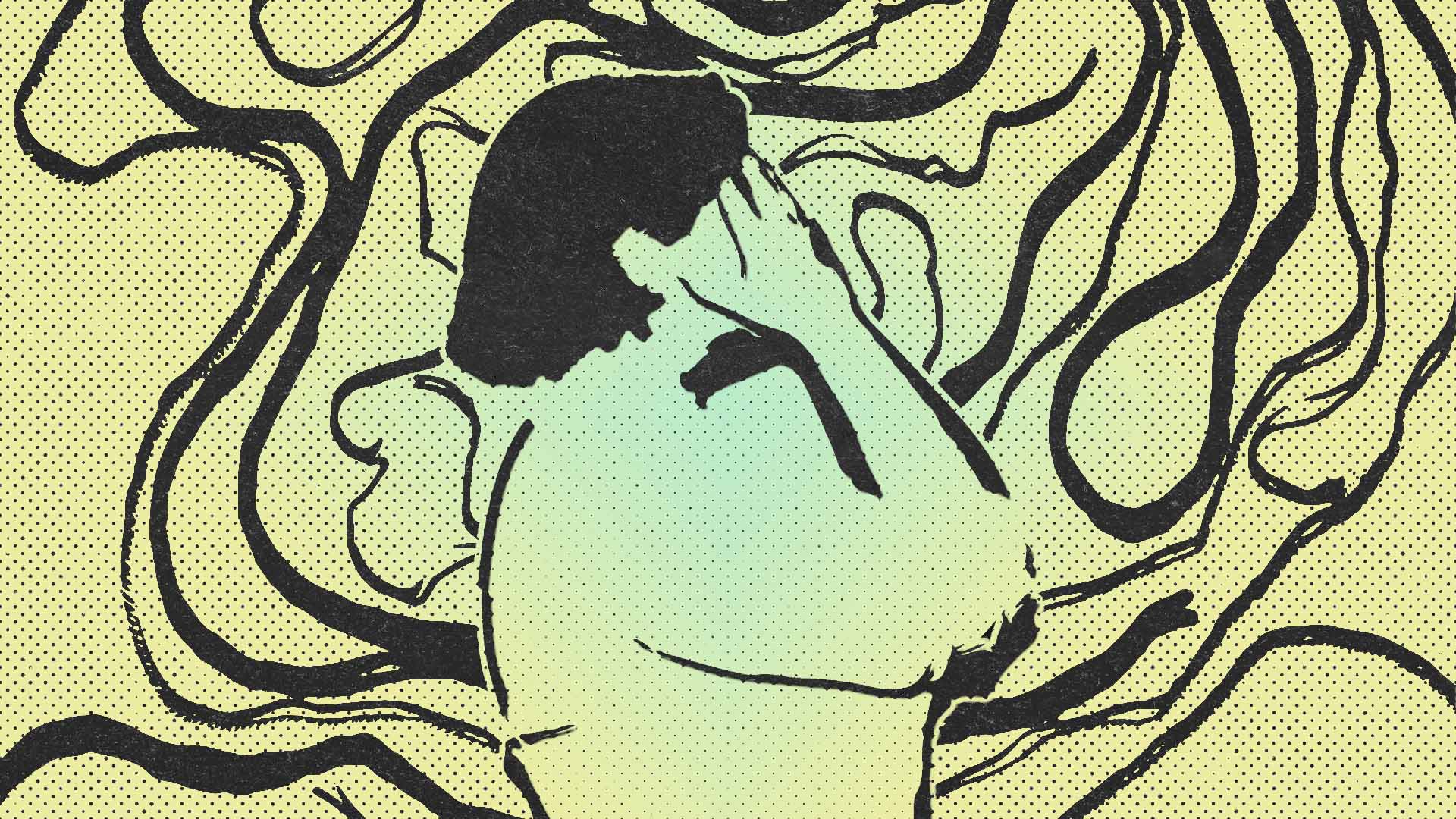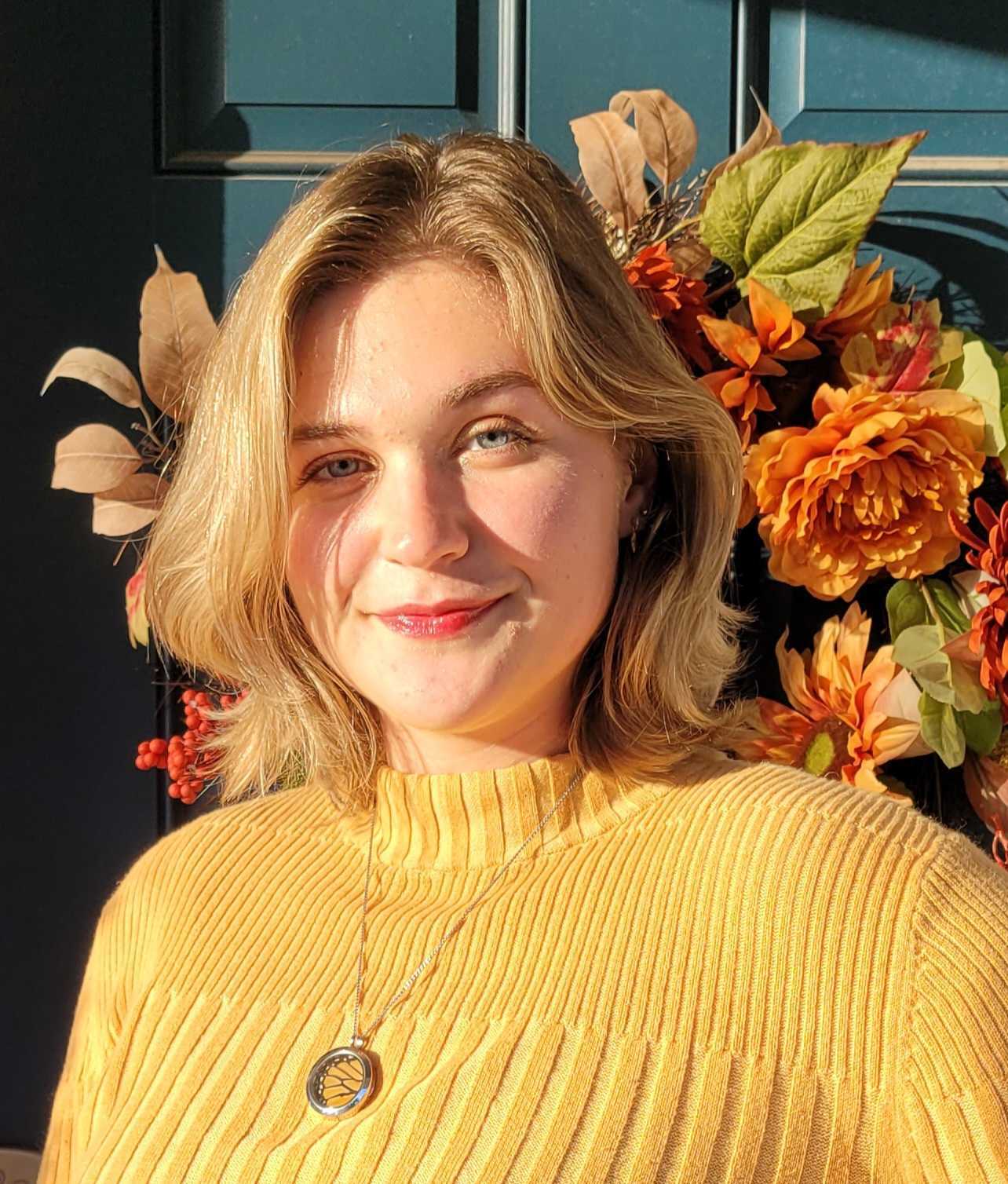Using psychology and yarn to help cope with anxiety

Dec. 13, 2023 | Story by Elise Plunk | Graphic by Matthew Cupelli
This article is part of Atrium’s Winter 2023 issue. To view the print edition online, visit our Issuu here
Editor’s note: This piece contains mentions of panic attacks and anxiety.
Slip, yarn over. Chain 15. Chain two. Flip the stitch. Skip two. Double crochet into the next 15. Chain two. Flip. Repeat.
The yarn slips through my fingers with a whisper, my hands following the memory of thousands of stitches looped, checked for errors and redone again. Soft cotton or bamboo works best, the gentle tug of string against the crochet hook providing just enough texture to allow a good grip on the task at hand. Ignore the ache of panic behind my eyes; focus on the stitches.
Three more double crochets. Two more. Now one. Now flip, and do it again
Most times, the panic starts with a headache.
Not all the time. Sometimes it starts in the chest, a sudden heat blooming out from just below the hollow of my throat. My heart beats faster, tripping over itself to keep up with the rapid pace of my anxious thoughts. But most times it starts in my head, right behind my eyes. The panic descends like a veil across my face, coarse and suffocating.
What if… But no, that’s irrational, it wouldn’t happen like that… Except for that one time… Oh god, it’s going to happen just like that….
The pain expands into the tips of my fingers, and they start to shake. My face turns red, the color climbing down my neck. Suddenly, I’m not handling the stress of an upcoming exam. I’m a young rabbit, frantically sprinting to my warren, hawk circling overhead. My thoughts turn to TV static, buzzing, blinding, screaming in my ears.
Maybe the scream was me? I don’t really know. What do I know?
I know what science says, I guess. The Anxiety and Depression Association of America reports anxiety disorders as “the most common mental illness in the U.S.” It affects 40 million adults, or just over 19% of the population, every year. I know that anxiety disorders can arise from a complex set of factors, which include family history, brain chemistry, life events, personality and more. I know that anxiety is not only complex but also dangerous — people with anxiety disorders are 6 times more likely to be hospitalized based on a psychiatric condition than people without anxiety disorders.
No doubt, things worry me. Small issues like incomplete grocery lists and scheduling mishaps add up in my mind; I make a typo on a work email and fear getting fired. I get angry with myself for getting stressed over simple tasks, my car breaks down, and it’s all too much. My adrenaline increases, senses flood with cortisol, and I’m ready to do what I was made to do, fulfill the primal urge to fight, defend myself or run and hide from the oncoming threat. But with nothing to fight and nothing to hide from, my body turns the panic inward, leaving my chest hurting, hands shaking, mind tangling.
What do I do?
Stress can lead to an early death.
Okay, yeah, that thought doesn’t help.
It’s true, though. There are studies….
Stop. Not right now. OK, OK, think; my body needs something to fight. Stress, in normal amounts— this is not normal— is supposed to prepare you for action. The American Psychological Association says that “Relaxation techniques and other stress-relieving activities and therapies have been shown to effectively reduce muscle tension, decrease the incidence of certain stress-related disorders, such as headache, and increase a sense of well-being.” That’s good! I can relax. I can do that.
You’re not answering the “how” right now.
Yes, yes, the how. The how….
My hands continue to shake as black spots creep across my sight, the Swiss cheese of my vision slowly collapsing. I see my phone sitting on the desk, silent black screen beckoning, comforting.
No. My head hurts; bright lights and loud sounds are not calming.
Think, think.
I clench my hands into fists to stop the shaking, my knuckles white with strain. I see a ball of yellow cotton yarn in the corner. I remember seeing the soft, yellow skein at the craft store warehouse sale, the sweet, lemony brightness peeking out to say hello from the bottom shelf. I’d used the yarn to guide me out of panics I’d experienced before, using the thought of a sweater, candy pink and soft yellow, with little hints of orange on the sleeves, to lead me out of the labyrinth.
Bilateral stimulation.
Yes. Repetitive movement on the left and right sides of the body. It works with sounds and images, too, but with the hook and yarn, both hands moving, mind focused, I could get my brain to calm down. A National Library of Medicine study examining the role of bilateral stimulation in EMDR therapy, or eye movement desensitization and reprocessing, concluded that bilateral stimulation “induces relaxation and comfortable feelings” and could help improve cognitive processing.
I could have relief.
I launch myself across the room toward the ball, skinning my knees on the carpet as I grab at the ground looking for a crochet hook.
I need it, where is it?
Tears spill over my cheeks. It hurts to breathe. I find the purple metal hook hidden under the raw edge of the carpet. I snatch it up and sit cross-legged, twisting my left hand into the soft cotton, pulling out the end of the string and starting.
Slip. Chain 15. Chain two. Flip the stitch. Skip two. Double crochet into the next 15. Chain two. Flip. Repeat.
My breathing slows. Chain two. The tears stop. Double crochet. The headache, the spots on my vision, the pain ebbs away as I take the tangle of my thoughts and order them in rows of yellow yarn, then pink, then hints of orange.
The moment eases as the crochet hook clicks against my nails. I take a breath in, holding it briefly as I pause, yarn in hand.
My thoughts get tangled up sometimes; chronic anxiety takes a toll on anyone who experiences it, in whatever form it presents itself as. But there are ways to manage it, even if it starts with something as simple and soft as a ball of yarn. There’s hope.
I breathe out. I crochet.
Slip, double crochet, chain two, flip the stitch…

Elise Plunk
Elise Plunk is the editor-in-chief of Atrium Magazine. She has worked as a reporter for WUFT, environmental communicator for the Thompson Earth Systems Institute as well as an author, copy editor and managing editor at Atrium over the last 2 years. In her free time, Elise enjoys weightlifting, making jewelry and exploring state and national parks.